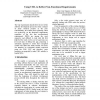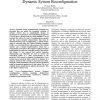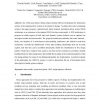6 search results - page 1 / 2 » Using UML to reflect non-functional requirements |
ICAS
2006
IEEE
13 years 11 months ago
2006
IEEE
Service-oriented grids are grid computing systems built with the notion of service-oriented architecture (SOA). Using two maract concepts, services and connections between service...
CASCON
2001
13 years 7 months ago
2001
The way requirements should drive the rest of the software development process has been a subject of many research projects in the past. Unfortunately, all of them focus primarily...
ECBS
2003
IEEE
13 years 10 months ago
2003
IEEE
- In concert with customer and marketing staffs, systems engineers often formulate and codify an initial overall software system solution to fulfill customer needs. Without a focus...
JSW
2008
13 years 5 months ago
2008
Dynamic system reconfiguration techniques are presented that can enable the systematic evolution of software systems due to unanticipated changes in specification or requirements. ...
CORR
2004
Springer
13 years 5 months ago
2004
Springer
One of the main factors driving object-oriented software development for information systems is the requirement for systems to be tolerant to change. To address this issue in desig...



